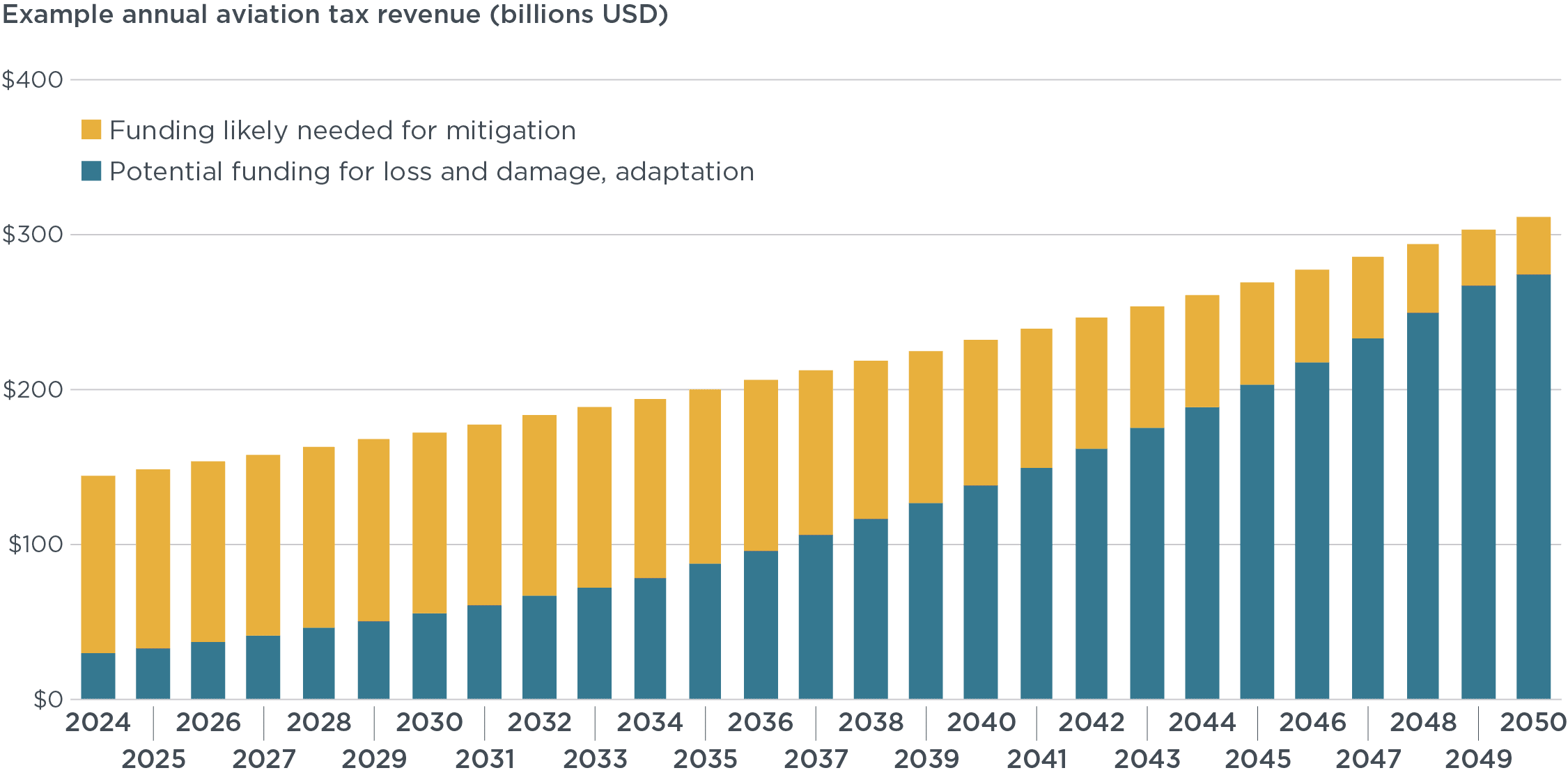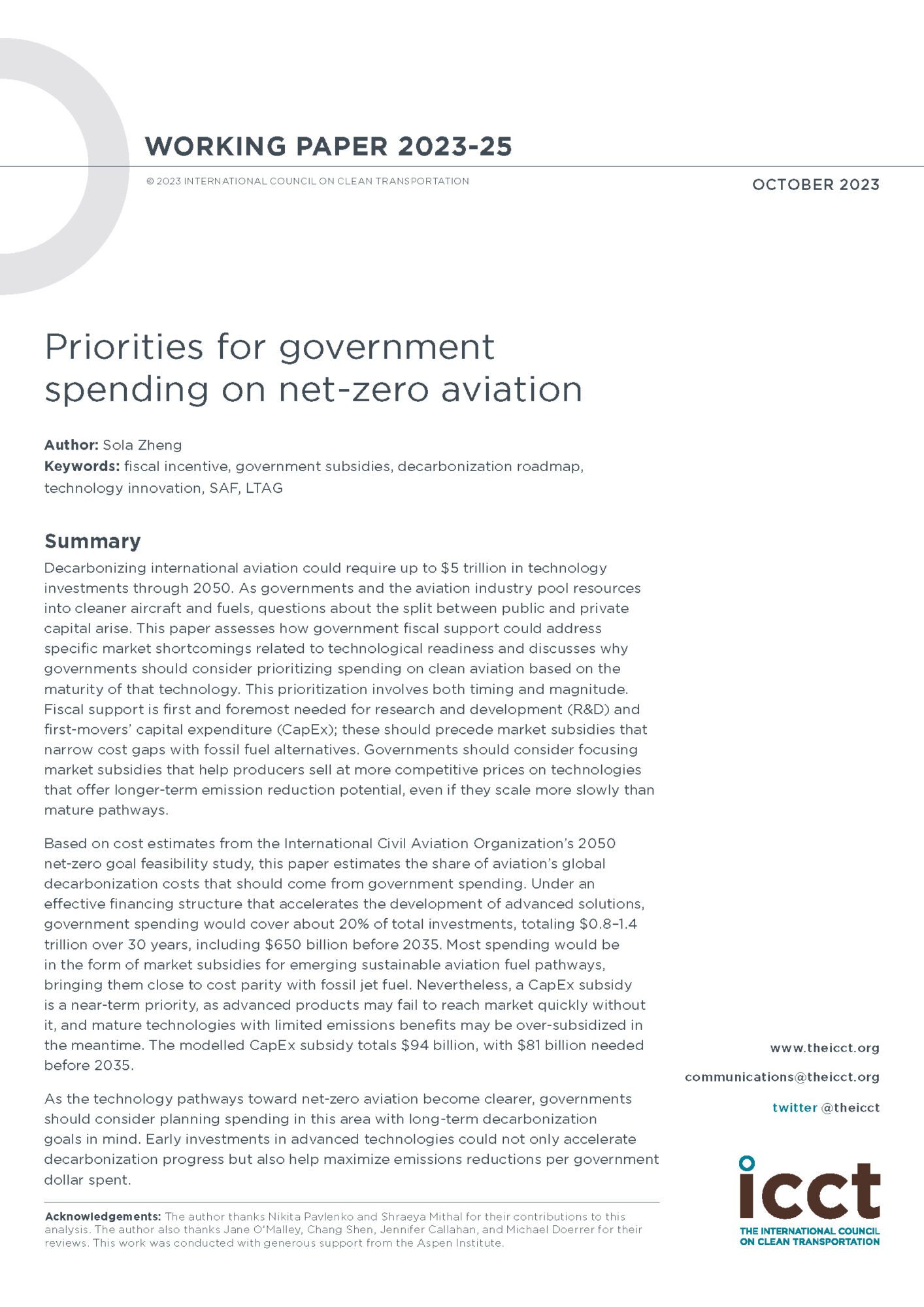CO2 emissions from commercial aviation: 2013, 2018, and 2019
Blog
Taxing aviation for loss and damage caused by climate change
The world’s most climate-vulnerable countries scored a victory at COP28 when delegates agreed to implement a Loss and Damage Fund. The fund aims to collect money from wealthier countries and provide it to developing nations contending with the worst impacts of global warming.
But to have a real impact, the fund needs diverse and long-lasting revenue streams, in addition to pledges already made by some national governments. That’s why various taxes have been proposed over the years, including levies on aviation, maritime shipping, and financial transactions.
In light of the COP developments, we analyzed how much revenue a tax on airplane tickets could raise for the Loss and Damage Fund. Such a tax would provide a more stable and scalable funding source than voluntary, typically one-off financial assistance from wealthier countries.
Table 1 shows that $164 billion could be raised in a year if economy-class tickets were taxed at $30 each and premium-class tickets at $120 each. We selected $30 for economy seats based on the air passenger levy proposed by the United Nations Special Rapporteur on Human Rights and the Environment. In a 2021 policy brief, the special rapporteur (an independent expert appointed by the United Nations) outlined a tax of $10 to $75 for economy and business tickets to help pay for climate-related losses, damages, and adaptation. We put the levy at $120 for premium-class seats because our research shows that premium seating is 2.6 to 4.3 times more carbon-intensive per person than economy seating. Exempting economy tickets to and from lower-income countries would help ensure that the tourism industry and nascent aviation market in those countries are not unduly burdened. Such an exemption would reduce the total tax revenue collected by $19 billion. Taxing just international flights still results in a sizeable chunk of revenue: $68 billion a year or, with the exemption, $58 billion a year.
Table 1. Example ticket tax revenues raised by flight type, seating class, and country income levels.
| Type of flight | Country income levela |
Million tickets sold, 2019 | Estimated revenues from ticket tax (billions USD) |
||||
| Economy class | Premium class | Total | Economy class, $30/ticketb | Premium class, $120/ticketb | Total | ||
| Domestic | Higher income | 2,422 | 104 | 2,526 | $73 | $12 | $85 |
| Lower income | 316c | 6 | 322 | $9c | $1 | $10 | |
| International | Higher income | 1,462 | 113 | 1,575 | $44 | $14 | $57 |
| Lower income | 326c | 11 | 337 | $10c | $1 | $11 | |
| Total without exemption | 4,525 | 233 | 4,759 | $136 | $28 | $164 | |
| Total with exemption | 3,884 | 233 | 4,117 | $117 | $28 | $145 | |
a Flights are attributed to “lower-income” countries if they depart from or arrive in a country that is classified as low income or lower middle income by the World Bank; the remaining flights are attributed to “higher-income” countries for the purpose of this analysis.
b These are example tax rates for modeling purposes, not ICCT policy proposals.
c Number of tickets and potential revenue exempted if economy-class tickets for flights to and from lower-income countries are not taxed.
There are already examples of such taxes. The French “solidarity tax on airplane tickets” charges €2.63-63.07 per ticket to finance efforts by the global health initiative Unitaid to combat infectious diseases in the Global South. The tax raised over €1 billion in its first decade. Though this tax is only one example, it suggests that aviation taxes can be used to raise significant funds for international causes.
Moreover, the ICCT’s previous research found that certain aviation tax policies can be a more equitable way to raise revenue from those most responsible for the sector’s emissions. A tax on frequent flyers would raise 90% of its revenue from the richest 10% of the global population.
There are, however, competing needs for the revenues from a potential aviation ticket tax. Decarbonizing international aviation will require up to $5 trillion in technology investments by 2050. We recently published an analysis showing that these investments—in order to have the greatest and quickest impact on reducing greenhouse gas emissions—should be prioritized early in any taxation scenario and focused on emerging technologies.
Policymakers could, therefore, consider frontloading aviation tax revenues for mitigation in the near term and then gradually shift toward financial assistance related to loss and damage and to helping developing nations adapt to climate change. In addition, revenue from a domestic ticket tax could be earmarked for subsidizing sustainable aviation fuels within the country, while an international ticket tax can fund mitigation, adaptation, and loss and damage. Figure 1 illustrates how revenue could be apportioned over 30 years, using the same per-ticket taxes as outlined above.

Figure 1. Example allocation structure of aviation ticket tax revenue, assuming 50% of the revenue from international flights initially and an increasing share of all revenues (up to 80% domestic and 100% international) can potentially be used to help vulnerable countries with adaptation efforts and loss and damage.
Even if new aviation taxes went solely to the Loss and Damage Fund, the revenues will likely fall short of the need. Some studies project loss and damage needs of at least $400 billion each year. But even limited funding could have a huge impact for some countries. Small island developing states (SIDS) are typically extremely climate vulnerable but need less funding per disaster because of their small populations and geographic areas. Damage mitigation for the 2022 floods in Pakistan was estimated at $16.3 billion, 92 times higher than the $177 million requested by the island nation of Vanuatu for the entire country’s loss and damage that year.
In the best-case scenario, aviation can contribute to the funding mix for loss and damage, as long as such taxes are equitably designed with the goals of both decarbonizing the industry and helping those nations most injured by climate change.
Authors
Ethan Kellogg
Intern
Related Publications
PRIORITIES FOR GOVERNMENT SPENDING ON NET-ZERO AVIATION
The research advocates for a strategic approach, emphasizing that fiscal support should initially focus on research and development (R&D) and early capital expenditure (CapEx) for emerging clean aviation technologies before market subsidies aimed at narrowing cost gaps with fossil fuels.


